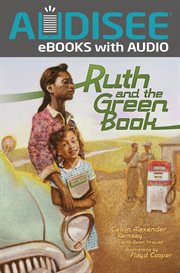Fiction
eBook
Details
PUBLISHED
Made available through hoopla
DESCRIPTION
1 online resource
ISBN/ISSN
LANGUAGE
NOTES
Audisee® eBooks with Audio combine professional narration and sentence highlighting for an engaging read aloud experience! The picture book inspiration for the Academy Award-winning film The Green Book Ruth was so excited to take a trip in her family's new car! In the early 1950s, few African Americans could afford to buy cars, so this would be an adventure. But she soon found out that black travelers weren't treated very well in some towns. Many hotels and gas stations refused service to black people. Daddy was upset about something called Jim Crow laws . . . Finally, a friendly attendant at a gas station showed Ruth's family The Green Book. It listed all of the places that would welcome black travelers. With this guidebook-and the kindness of strangers-Ruth could finally make a safe journey from Chicago to her grandma's house in Alabama. Ruth's story is fiction, but The Green Book and its role in helping a generation of African American travelers avoid some of the indignities of Jim Crow are historical fact. "Ruth's father just bought a beautiful new 1952 Buick, making it a big day for this African-American family. They are going from Chicago to Alabama to visit Grandma. Ruth is very excited to be traveling, but the family encounters 'whites only' restrooms, hotels, and restaurants along the way. It's very discouraging and sometimes scary, but they learn that some friendly faces may be found at local Esso stations, which are among the few franchises open to black businessmen. At a station near the Georgia border, they are introduced to Victor H. Green's The Negro Motorist Green Book, an early AAA guidebook of sorts that listed establishments or homes that would serve African Americans-be it for general services, housing, or meals. Ruth eventually becomes the Green Book specialist in the family, helping to guide them to an auto-repair shop or an inn that would welcome them. But, the best part of the trip is finally arriving at Grandma's, as illustrated by the loving expressions on all faces. A one-page concluding summary discusses the importance of The Green Book, which was in use from 1936-1964, when the Civil Rights Act was finally signed, banning racial discrimination. The realistic illustrations are done in oil wash on board, a self-described 'subtractive process.' The picture is painted, then erased to 'paint' the final product. Overall, there is a sepialike quality to the art, giving the impression of gazing at old color photos. This is an important addition to picture book collections, useful as a discussion-starter on Civil Rights or as a stand-alone story." --School Library Journal "Ruth is excited to be driving with her parents from Chicago to Alabama in their 'very own automobile-a 1952 Buick!' The trip starts out well, but the family continually runs up against segregation until they learn about The Negro Motorist Green Book, a pamphlet 'to help black people who were traveling.' Ramsey fashions a well-told historical narrative, supported by Cooper's expressive paintings." --The Horn Book Guide "An ever-expanding system of roads and highways beckoned to motorists in the mid-1900s, but the glamour of the open road was often illusory for African-American citizens, particularly those traversing the Jim Crow South. In this fictional account of a family trip, Ramsey introduces young listeners to the blatant discrimination facing those travelers, but more importantly, to the network of businesses and individuals who opened their doors with welcome assistance. The Negro Motorist Green Book, devised and expanded by Victor Green, was an invaluable aid, listing black-owned service stations, restaurants, and overnight accommodations. As narrator Ruth and her parents make their way from Chicago to her grandmother in Alabama, the girl becomes adept at using their seventy-five-cent resource and passes along information about the book to another beset traveler they meet at an inn
Mode of access: World Wide Web







